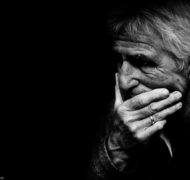Finding Peace in a World of Fear
Blog / Produced by The High Calling
Fear is designed to serve us. Not control us. A healthy response to fear pays attention to it but does not surrender control.
In 2014, Wilkinson College of Arts, Humanities, and Social Sciences reported on their findings of American’s top fears. The report grouped these fears into four categories: Personal Fears and Concerns, Fears About Government and Immigration, Concerns About the Environment and Natural Disasters, and Manmade Disasters.
Then, there’s this list of the top 100 phobias, which includes:
- Arachnophobia—The fear of spiders,
- Alektorophobia—The fear of chickens, and
- Hippopotomonstrosesquippedaliophobia—The fear of long words.
Yes. It’s a real thing.
But fearing long words is not particularly useful to us. Fear is supposed to be useful. Our physical bodies warn us when we need to pay special attention so that we’ll stay safe. That warning is something we call fear. It is good and right, and it can serve us well. And that is just the point.
Fear is designed to serve us. Not control us. Fear says, “Well, here’s something new and a little bit risky. Have you paid attention to the risks?” A healthy response to fear pays attention to it but does not surrender control.
When we let our fear control us, it becomes anxiety. Joseph LeDoux, Ph.D., professor of neuroscience and psychology at New York University helps us understand the difference between fear and anxiety in this way:
Scientists generally define fear as a negative emotional state triggered by the presence of a stimulus … that has the potential to cause harm, and anxiety as a negative emotional state in which the threat is not present but anticipated.
In other words, fear exists in the presence of a threat. Anxiety anticipates a threat that doesn’t actually exist.
Consider this story of fear Jennifer shared with us:
After my accident in 2009, it took a long time to get behind the wheel of a car without fear. And when I did, I purposely avoided the stretch of highway where my accident happened.
When Jennifer experienced that accident, it was a fearful event. And, subsequently, when she thought about the accident in the time after she had recovered from her injuries, she experienced anxiety. So, she took matters into her own hands:
A year after the accident, I decided I needed to literally FACE MY FEARS. I went back to the site of the accident. I pulled my van into a farm driveway, and walked the ditch where my old van landed the winter before. I re-felt everything. And then I let myself feel ALIVE. Because I was. I am. I made it. I was okay. I am okay.
Jennifer’s anxiety is understandable. Her car accident was such a terrible experience that it sometimes dominated her imagination.
As Dr. LeDoux points out: “Human anxiety is greatly amplified by our ability to imagine the future, and our place in it.” Jennifer refused to think herself scared. She chose to focus, not on the trauma of the past, but on her peace in the present moment and her hope for the future.
Take, for example, my colleague, Marcus Goodyear. He is afraid to jump off a cliff at Laity Lodge because he is aware of all the things that could go wrong. His knowledge of the Law of Gravity and other things that have to do with physics keep him from experiencing the thrill of free-falling thousands of feet (I may be exaggerating) into a freezing cold body of water. It doesn’t matter that second graders jump off that very same cliff, day after day during camping season. For Marcus, when it comes to jumping off the cliff into Blue Hole, it really is mind over matter.
The only way to conquer that fear is to jump. Or not.
Maybe Marcus will follow the lead of our friend, David, who told us this story of conquering fear:
I went up in my attic crawlspace to replace a light fixture. I couldn't breathe in the small space and felt like passing out. So I paid someone $200 and felt really great about it.
“Fear not” is a phrase that shows up in the bible quite a bit. Some people say those two words appear together 365 times in the bible—once for every day of the year. Often, the words show up when an angel of the Lord suddenly appears on the scene. Which makes sense. Imagine an angel of the Lord appeared right now with light and thunder and a big fiery sword. I’d be so afraid I wouldn’t be able to breathe.
Fear not. It is our reassurance that—despite how things may look on the surface—God has things under control. Now that doesn’t mean the circumstances aren’t difficult or scary or even dangerous. Just ask Mary or Moses or Gideon, each of whom faced circumstances we might deem petrifying.
Or ask Rachel Ranier Goode, who writes about the fear of being twice held at gunpoint. In the years since, Rachel has struggled with feelings of fear and anxiety. Searching the scriptures for freedom, Rachel uncovered this profound truth:
In Scripture, it’s never: fear not, you won’t be robbed. Or fear not, cancer won’t come. It isn’t fear not, your children can’t be harmed, your body won’t be scratched, your finances won’t be rocked, your spouse won’t ever betray. Oh no, Scripture promises that life will get hard. “In this world you will have trouble. But take heart!” (John 16:33). Take heart? In this world full of trouble, why should we take heart!?
We “take heart” for one reason: nothing can separate us from the love of Christ.
Then Rachel shared more in a comment she left for me on Facebook:
Our greatest loves dictate our greatest fears. And if our greatest loves are things that can be lost, we have reason to fear. But if our greatest Love is the One who cannot be lost, only then can we be fearless. (Which may sound like pie-in-the-sky theory, but I can tell you it transformed me from someone who lived in terror to a person at peace.)
It may sound like a pie-in-the-sky theory, but I’ll take a slice of that pie.











